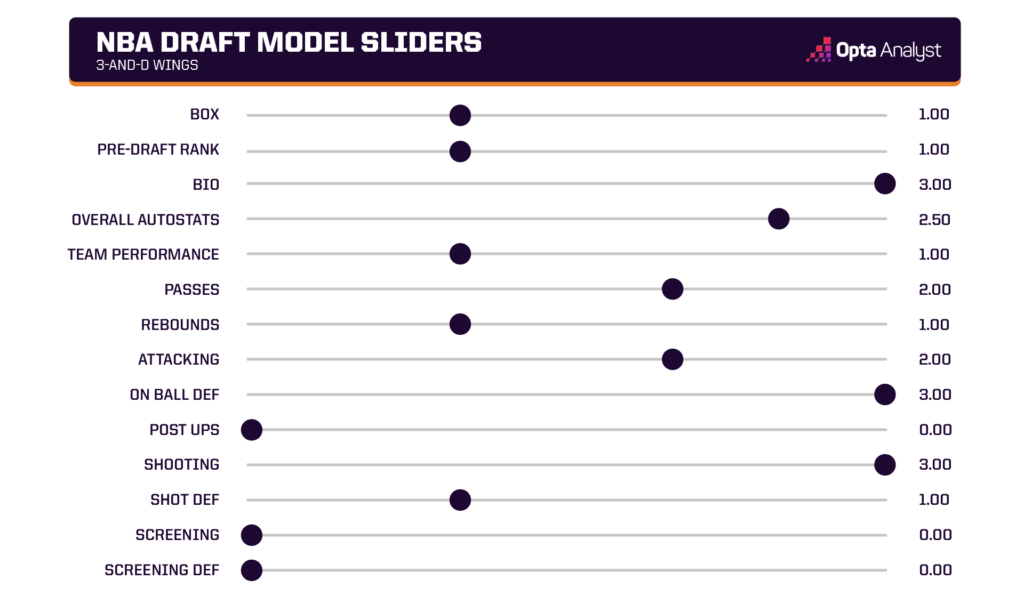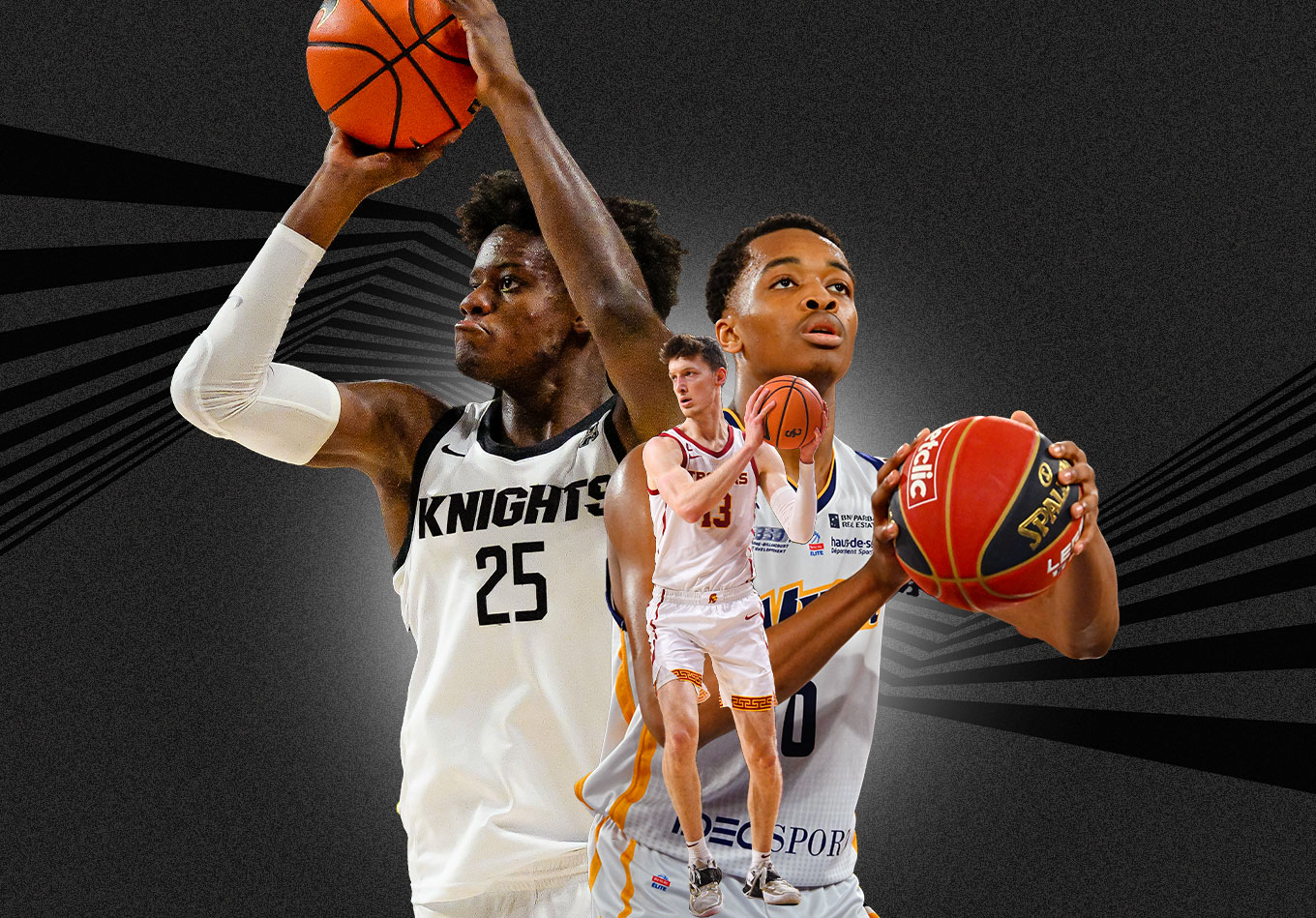With the Denver Nuggets and Miami Heat meeting in the NBA Finals, there has been a lot of emphasis on the return of the big man.
It’s a valid exploration. Centers had been de-emphasized, and, at least at the star level, are making a bit of a comeback.
But the days of multiple true big men on the floor being the norm are not coming back. Even though the Nuggets built their team around the singular brilliance of Nikola Jokić, they needed Aaron Gordon to play alongside him in the frontcourt.
We touched on the importance of two-way wings last year prior to the draft, and how their versatility affects team building. Teams can play several two-way wings together and the same can’t be said for other positions. So, while certain teams might be targeting point guards and big men, every team in the league could use another two-way wing.
Thanks to the sliders in our NBA Draft model, we can use data to try and find some of the players that offer two-way potential at the wing. The sliders can be used to emphasize certain physical and statistical traits and compare them to current NBA players’ stats at the time they were entering the league.
Our draft model is derived from an array of volume- and rate-based statistical inputs, consensus draft rankings and biographical/anthropometric information to determine where a prospect stands relative to his peers in the class. It also includes data from AutoStats, which leverages AI-enhanced body recognition technology to identify player position and movement across the entirety of the court.
In our search for two-way wings, we emphasized shooting, on-ball defense, and bio data the most (see sliders below). This allows us to compare players physically and statistically, which is imperative for looking at players that can handle the wing in the NBA.
In a change from last year, we have decided to base the rankings on the total DRIP (a projection of a player’s contribution to a team’s plus-minus per 100 possessions) over the first six years of a player’s career, rather than weighting it for a specific season. The teams in the NBA are in different points of competitive cycles, so, when ranking players, it makes the most sense to weigh each year equally.

Our secondary characteristics that were emphasized somewhat were passing, attacking and AutoStats data. It’s no longer enough to be a “3-and-D” wing. Players on the wing in the modern NBA must be able to drive or make the correct extra read against a rotating defense. And AutoStats data is extremely useful in tracking player movements and likening them to successful players in today’s NBA.
Last season, we highlighted three players that the model liked more than public consensus, and the rookie seasons were encouraging for a couple of those players. Jeremy Sochan averaged 11.0 points, showed his passing and defensive abilities, and looks to be a perfect frontcourt mate to potential No. 1 pick Victor Wembanyama. Tari Eason flashed his potential on both sides of the ball as well and had four games of 20 or more points.
Both players made the NBA’s All-Rookie Second Team.
Unfortunately, our sleeper pick from the model never got a chance to show his skills, as E.J. Liddell tore his ACL in the summer league and missed the season.
But with positive results from last year, we’ll look at two higher-end prospects and one sleeper in the 2023 draft that, based on the model, could outperform their draft slot.
Taylor Hendricks, UCF (Two-Way Wing Ranking: 3)
Hendricks is a premium prospect in this draft who is almost universally regarded as a player that will hear his name called in the top 10. And yet, our model thinks those lofty expectations are still too low.
It’s easy to see the positives on both sides of the ball. On offense, Hendricks is a 6-toot-9 wing with a 7-foot wingspan whose size and quick release allow him to get off jumpers quickly in catch-and-shoot situations.
He knocked 3-pointers at 39.4% clip while shooting 78.2% from the line.
The rest of his offensive game is still a work in progress. He can’t finish inside well, especially with his left hand.
He had some struggles against the more athletic teams he faced that were able to recover quickly enough to force him to make tough plays in traffic. He went 2 for 12 against Memphis in the AAC quarterfinal and 3 for 10 against Oregon in the second round of the NIT.
If he does develop driving skills and the ability to make quick decisions while on the move, he could be a star. Because even as a secondary offensive option, Hendricks can have a huge impact on the game on the defensive end.
This draft class features several switchable, athletic defenders and Hendricks profiles as one of the best, with his combination of athleticism and awareness. He made several plays on defense this year that looked like feats of athleticism on first glance, but were made possible by his excellent sense of timing.
There aren’t many players in this draft that could make this block. Hendricks doesn’t leave his man too early, nor is he too late to make an absurd block at the rim. And he displays this intuition all over the court on defense.
There are concerns about his lack of game action against elite competition, and his assist-to-turnover ratio is neutral. But his understanding of the game on defense lends some optimism to the fact that he’ll eventually find a rhythm as a passer, and the model likes his athletic markers and stats enough to be very high on his future.
At worst, Hendricks offers shooting and athleticism on defense. And if he continues to improve at the weaker parts of his game (all which seem fixable), he could be the quintessential modern forward.
Bilal Coulibaly, Metropolitans 92 (Two-Way Wing Rating: 6)
He’s not even the best prospect on his team in France, but Coulibaly is worth a top-10 pick anyway.
As a young prospect on a professional team that was already featuring a young transcendent talent, Coulibaly didn’t always have the biggest role on offense. And for a player in a secondary role, his turnover rate was too high and his shooting was just OK (34% on 3-pointers, 71% on free throws).
But, as the season went on, Coulibaly developed at a rapid pace. His shooting form looked much better at the end of the year than the start of it, and he started to show more advanced passes.
That is a pretty pass for someone who hasn’t turned 19 yet. He’s starting to learn how to leverage his elite athleticism into an advantage and to make the scrambling defense suffer because of its response to that advantage.
Defensively, Coulibaly joins Hendricks as someone with extremely high upside. He’s shorter than Hendricks (6-foot-6) but has a reported 7-foot-3 wingspan. He gave the less athletic players in France absolute fits when they dribbled near him. And, like Hendricks, he showed recognition on defense, particularly in help, and has the athleticism to make that recognition useful.
The model sees Coulibaly as one of the more impactful defenders in the draft. If his shot continues to come around and he can be a solid secondary option, he could be a very valuable player.
Drew Peterson, USC (Two-Way Wing Rating: 10)
One of the most fun things about models is the outliers. And Peterson is quite the outlier.
Let’s start with the obvious red flags. Peterson played five years in college, is already 23 years old, and averaged a good but not elite 13.9 points in his final season. And, while he’s athletic, he’s definitely not elite in that area.
So why does the model love Peterson’s game when we turn up the two-way wing attributes? Let’s start with his shooting. He only shot 35.8% on 3-pointers his fifth year of college, but that was down from 41.2% in his fourth year and his free throw shooting went up from 71.7% to 75.2%, which suggests that his 3-point shooting decline may be more random than anything.
And the shot certainly looked good. He came off screens and fired 3-pointers with a quick release. There are stand-still shooters and there are guys that take that to the next level as movement shooters, and Peterson is a movement shooter.
He was able to create for himself his last few years of college, and his playmaking kept improving as well (career-high 4.3 assists per game in his last year). He’ll never be the go-to guy on an offense, but he’s already developed enough other skills to show he’ll have use on that end in a secondary role. And if his role diminishes in the NBA, he’ll likely be a more efficient player.
Can he stay on the floor defensively? He doesn’t have the best lateral quickness, and got beat off the dribble some in college, which is a big warning sign. He’ll need to continue to add weight so he doesn’t get pushed off his spots, either. But he is 6-foot-9 and his defensive awareness continued to improve throughout his collegiate career.
Is he a top-10 prospect if a team is looking for the qualities of a two-way wing? Most likely not, as his age and lack of incredible production alone disqualify him from those lofty heights. But that doesn’t mean you should ignore what the model says.
We’ve touched on how to view outliers in the model before, and it’s an important message here as well. Peterson is projected to go in the mid-to-late second round, and there’s a chance he isn’t drafted.
Teams in the second round would be wise to understand why the model has him as a valuable wing prospect. If he lands in the right situation for his development, he could be a steal, and, with where he is projected to be taken, he offers very little downside.
Player Comparisons
Check out our model’s player comparisons for Hendricks, Coulibaly, Peterson and more below.
These NBA comparisons are meant to be at the time those players were coming out of college, not at the peak of their NBA careers.
Data modeling by Matt Scott of Stats Perform. Enjoy this? Follow us on Twitter.
